Dominican friars are engaged in an incredible spiritual adventure: living from the passion for the salvation of souls which, eight centuries ago, set fire to the heart of St Dominic and to the hearts of his first companions.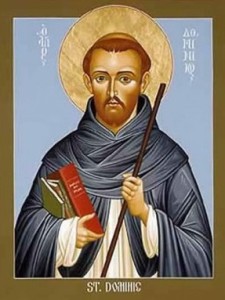
Dominic was born in 1170 in Caleruega, Spain. He received his education in Palencia. News of Dominic’s virtues reached the Bishop of Osma, who summoned Dominic and made him a Canon Regular of his church. Lead by Diego de Acebo, the prior of the community, he learned the basics of religious life and contemplation.
Diego became bishop of Osma and invited Dominic to travel with him as he spread the Gospel. Together in 1206, both men offered Pope Innocent III their services to save souls. The pope asked them to go preach to the Cathars of Languedoc. Contrary to the habits of the Cistercians, Dominic and Diego roamed the villages of Languedoc on foot, begging their bread.
Diego soon died, but Dominic continued to preach with the help of a community that had gathered in 1207 and was comprised of women who fled the Cathars and lived the common life in Prouilles. To preach the gospel better, in 1215 Dominic moved on to Toulouse with a few companions that were bound to him by profession. Soon they adopted a rule of life, based on that of St. Augustine. In a bull entitled Religious life, dated December 22, 1216, Pope Honorius III confirmed the Order as an Order of Canons Regular. In 1217 Dominic dispersed the brothers two by two to further the preaching mission. To train the best brothers in the preaching, Dominic chose to settle in two large university cities: Paris and Bologna.
Dominic continued to travel between Spain and Rome to establish the Order’s foundation. In 1220, delegates of the brothers gathered in Bologna to approve the first constitutions, the first laws governing the operation of the college. Dominic died in Bologna in 1221.
“Your Word is a lamp for my steps and a light for my path.” PS 119:105
ABOUT THE ORDER
The Order was founded by a Spaniard, Dominic de Guzman, and given Papal approval in 1216. The order was founded as a mendicant order, rather than a monastic order. Monastics, like Benedictines, are mainly cloistered and have no restrictions on owning property. Mendicants, such as the Dominicans and Franciscans, owned no property and survived by begging. Unlike monastics, Dominicans move from place to place – they enter the order as a whole, rather than a specific community.
Dominic was travelling in Southern France in 1203-1206, and encountered the Albigensians. They taught that the physical world was evil, a heresy which devalues our own humanity, devalues Christ, Who is truly God and truly man, and devalues the sacramental life of the Church.
St Dominic spent all night debating with an innkeeper in Toulouse, and realised that there was a great ignorance regarding the teaching of the Church. He saw the great need for preachers who knew and could teach the true faith. And so began the itinerant, mendicant life of the friars, not settled in one place, but moving from village to village, preaching and teaching as they went. It is said of St Dominic, that he spent all his time talking to people about God, and talking to God about people.
And so the Order spread, arriving in England in 1221, settling in Oxford so that the friars would have access to the University. As the New World was discovered, the friars followed, to preach the Truth to the native peoples, and, later, shocked by the actions of the conquerors, to advocate and fight for their rights.
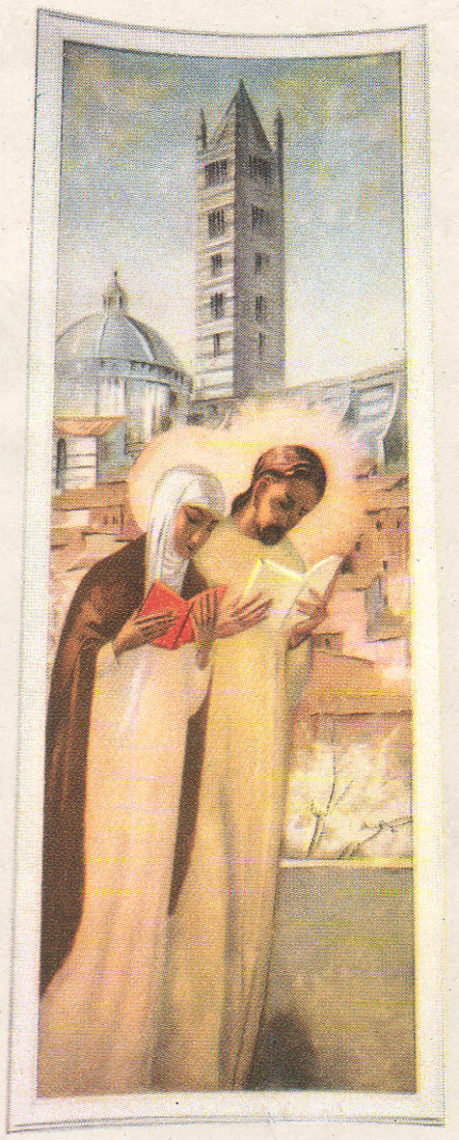 The Reformation lead to the destruction of every single priory in England, apart from Norwich, which was bought by the secular authorities, and is now a concert and event venue. But the main trace of the pre-reformation presence of the order in England are placenames such as Blackfriars in London.
The Reformation lead to the destruction of every single priory in England, apart from Norwich, which was bought by the secular authorities, and is now a concert and event venue. But the main trace of the pre-reformation presence of the order in England are placenames such as Blackfriars in London.
The Order is split into four branches, who all follow the same Rule (written by St Augustine), with variations according to style of life.
The First Order is the preaching Friars. They may or may not be ordained during the process of discernment; it depends on their particular vocation. They live a fraternal live in common, but are not tied to a particular monastery – they are called to “make the world their cloister” as they preach the Gospel for the salvation of souls.
The Second Order is the cloistered nuns. Unusually, they were founded first, some ten years before the friars. These women, free for God alone, live cloistered from the world, dedicated to praying for its needs, for, “just as in the Upper Room, Mary in her heart, with her prayerful presence, watched over the origins of the Church,so too now the Church’s journey is entrusted to the loving hearts and praying hands of cloistered nuns.” (Verbi Sponsa).
The Third Order is split in two. The Third Order Regular is Apostolic Sisters, they live in community, follow a set of rules & constitutions, have a common prayer life, generally have a particular apostolate, or work they do in the world, such as teaching, nursing, etc.
Whilst The first three groups make the vows of poverty, chastity and obedience, the Third Order Secular do not – we are free to marry or not, and are called, like all Catholics, to fidelity within marriage and chastity outside it. Lay Dominicans have secular jobs, and the Order as a whole has no call on my salary, other than such donations as charity deems prudent.
There is a period of discernment which is roughly the same for all branches of the Order, and is laid down by Canon Law:
Postulant – up to one year. “Postulant” comes from the Latin “Postulare,” “one who asks,” and this year is a year of asking God and the Order if this is where you are called.
Novice – 1 or 2 years
Temporary Vows – 3-5 years
At the end of temporary vows, you either make vows for ever or you leave. The period of discernment is to see if you really do have a call to live that particular life, in that particular community.
During the discernment period, which is anything up to 8 years, you are free to leave at any time, and even after you have made permanent vows, if you really, really, really decide you have to leave, you can – you’re not locked away for ever and ever and ever. It is all a period of gradually deepening the living of the life, seeing if this is what you’re called to. The Church recognises that you cannot fit a square peg into a round hole, and nor can you make a Carmelite out of a Dominican.
As the church is made up of many parts, but we are all one body, so each religious order has its own charism (mission), and the Order of Preachers’ particular charism is the preaching and teaching of Truth – one of our mottoes is “Veritas.” This charism is expressed in a four-fold way, under what are referred to as the four pillars of Dominican life – Prayer, Study, Community and Preaching. A Dominican friar will express the charism differently to a cloistered nun, who will express it differently to an apostolic sister, who will again be different to a lay Dominican.
The order is incarnational, as a challenge to the Albigensian heresy that it was founded to counter. Life is good, and to be valued and cherished. Dominicans are pro-life, and try and balance the spiritual and the physical.
The order has always had a deep devotion to the Mother of Christ, and that devotion is expressed in a variety of ways, through the rosary and through various prayers and traditions. Our Lady said to Blessed Jordan of Saxony that every time the Dominicans sang the Salve Regina, she prostrated herself before her Son, asking His blessing on St Dominic’s poor and lowly band. It is said that the Rosary was a gift to Dominic from Our Lady to aid him in converting the Albigensians. Mary is honoured as the queen of Preachers, and we turn to her maternal intercession every night as we sing the Salve Regina after night prayer.
The order is prayerful. Despite being a mendicant, active order, we pray the Office as monastics do.
The order is penitential. Please forget anything that Dan Brown might have come up with about hair shirts and spiky metal things, I cannot imagine our chaplain’s face if I were to ask him for permission to wear a hair shirt – but we try and fast on Fridays, we donate to charity, and there are times when we cannot do something fun because it clashes with our religious obligations – a birthday that falls on a Friday in Lent usually has its celebration moved to a more congenial day after Easter!
As preachers and teachers of truth, we are called to seek that truth through prayer and study.
And the Dominican life is a communal life – a lone Dominican is a rare thing indeed.
Prayer
“Lord, teach us to pray.” Dominican prayer is always seeking after the One Who is Truth, so that we can preach Him to others. And so we do not have many special ways of prayer, we seek to pray as the Church prays, with the Mass, the Liturgy of the hours, contemplative prayer, vocal prayer, and from that, we hope to make every action a living prayer. It is from prayer that everything else flows, the community life, the study and the preaching.
The Mass is the source and summit of Christian life. By hearing the Word of God, receiving Him in the Eucharist, we receive the strength we need in order to be Christ’s hands and feet in the world. We are encouraged to go to daily Mass where possible, but if not possible, then prayerful meditation on the Scripture readings for the day’s Mass is to be encouraged.
The Liturgy of the Hours arose out of the Jewish tradition of saying certain prayers at different hours of the day and night – we find in the Psalms expressions such as “I will meditate on thee in the morning”; “I rose at midnight to give praise to thee”; “Evening and morning, and at noon I will speak and declare: and he shall hear my voice”; “Seven times a day I have given praise to thee” and so on. And so there are eight “hours” of prayer, Matins, traditionally said at some time during the night (that one is generally reserved to cloistered nuns), and the seven Offices of the day, Lauds, Prime, Terce, Sext, None, Vespers, and Compline. The hours are spread through the day, with lauds and prime being morning prayers, Vespers is evening prayer and Compline is the last office of the day, said just before retiring for the night. As a lay Dominican, I am required to say Lauds and Vespers as a minimum, but I try and say most of them. Compline is particularly lovely – a thanks to God for the day just past and asking his blessing on the night to come.
All of the hours are based around psalms, readings from the Old and New Testament, Gospel canticles and readings from the Church Fathers. Between the Office and Mass, all the Bible is read in a year.
Another of the Dominican mottoes is “Contemplata aliis Tradere” – to contemplate, and to pass onto others the fruit of that contemplation. The Divine Office is the golden chain of grace that binds all the members of the order together, whether it is prayed in the stillness of a Monastic chapel or at the kitchen table of a flat in London with a cup of coffee in one hand and pigeons peering in the kitchen window. And by praying, contemplating the Divine Word, we can, like Mary, who “pondered these things in her heart,” pass on to others the fruit of this contemplation.
There will be more on the Rosary, the quintessential Dominican prayer, in another post.
Active Prayer – as Dominicans, we are not only called to contemplate God, but to pass onto others the fruit of that contemplation. We are an active order as well as a contemplative order – lead by the Spirit, we feed the hungry, give drink to the thirsty, clothe the naked, visit prisoners, shelter the homeless, visit the sick and bury the dead. We also instruct the ignorant,counsel the doubtful, admonish sinners, bear wrongs patiently, forgive offences willingly, comfort the afflicted, and pray for the living and the dead. Some of those are easier than others…
The idea is that the contemplative prayer is the wellspring from which the active prayer is given its impetus – St Catherine of Siena spent many years in contemplative prayer before emerging to do her work in the world, helping the ill and the poor, and striving for peace between the republics and principalities of Italy and for the return of the Papacy from Avignon to Rome. She carried on a long correspondence with Pope Gregory XI, also asking him to reform the clergy and the administration of the Papal States.
Through the Divine Office, the Mass, the Rosary, and our own private prayer, we pray for the needs of the world, the Church, and the Order.
Study
The Dominicans have always been associated with study. They settled in Oxford when they first arrived in London, and have been associated with the great universities wherever they travelled to.
You cannot preach without studying first – “first the bow is bent in study, before the arrow is loosed in preaching.” (Humbert of Romans). Study is the other half of Dominican contemplation, balancing with prayer to ensure that both our hearts and our minds are nourished in our love for the Truth, which is Christ himself. Study is an act of love of God, a way of seeking Christ and pondering His love.
Dominicans hold St Thomas Aquinas as a teacher and model of the Dominican life, for he displayed a thirst for truth and a willingness to seek it wherever and from whomever it may be found. We are mendicants, beggars after truth. As St Albert the Great said, “the whole word is theology for us, for the heavens proclaim the glory of God.” And so study causes us to marvel at God’s creation, to wonder at His greatness, and to humble ourselves before Him. Fr Timothy Radcliffe wrote that “it is through study, seeking to understand things and each other, that we recover a sense of astonishment at the miracle of creation.
Community
Dominican life is a communal life. Each fraternity meets once a month. We share a common life as far as we can, by praying, studying and discussing together. In this way, the different gifts of each member enrich the group as a whole, and in turn, the whole Order and the world. Each member of the fraternity has different talents and responsibilities, and those gifts are offered to God through the community. Many of the Order’s greatest saints have seen this community life as an echo of the friendship and love that God has for all of us, and the community is the school of love whereby we learn to show that love to all.
It’s not easy, and can in fact be the hardest part of the life, because we are all fallible human beings. Someone will send you demented with some habit or other, it’s inevitable, but the school of love helps us to see past the way that someone drives you up the wall, and instead see the image and likeness of God.
We are called to accept and embrace each other as members of the same body, “different indeed in talents and responsibilities, but equal in the bond of charity and profession” (Book of Constitutions and Ordinations of the Friars of the Order of Preachers). In this way, our Dominican life reflects, through a glass, darkly, the life of the God whom we seek after and preach to others.
Our monthly meeting follows a set pattern. We go to Mass together, we pray together, we eat together, and then we study together. Each year we have a theme for the study, and we are all expected to take a full part in the discussions, which are led by a different member of the community each month. Every member has something to offer the study, whether it is knowledge of Biblical Hebrew (not me) or knowledge of how the Ancient Israelites made bread (me. What can I say? I know weird stuff). By sharing the fruits of our knowledge, all are enriched.
Preaching
Whilst we are an Order of Preachers, the Preaching follows from everything else – we cannot preach the truth of Christ if we have not sought that truth through prayer, study and community.
As lay Dominicans, it would only be very rarely that we would preach in church, and we would not give the sermon at Mass – per Canon law, that is a privilege reserved for Deacons, Priests, and, under certain circumstances, the superior of a female religious community.
However, St Francis said that we should “preach the Gospel at all times, using words if necessary,” as the grace that flows into us through prayer, and community life, and study, should, inspired by the Holy Spirit, flow out through our lives, which should be a continuous preaching of the Gospel.
As Timothy Radcliffe said, “We meet in each new age the challenge of new ways of seeing the world, new technologies, and new intellectual tools.”
Many Dominicans have blogs, including various monasteries of cloistered nuns,, and use Facebook, Twitter and internet forums to preach the truth of Christ.
“I do not consider myself worthy of anything in this Order, for I have been nothing but pleased with it.” Blessed Reginald of Orleans, OP. Ref : https://londonlaydominicans.wordpress.com/laudare-benedicere-praedicare/
Dominican Locations in Ulster
Coleraine –It was known as the Abbey of the Bann. Although its origins are disputed it was probably founded by the Cambrian McQuillans. It was ‘voluntarily’ given up on 1st January 1543. However, by 1641 the Dominicans had again settled in Coleraine and in 1670 Oliver Plunkett recorded between four and ten friars. In 1767 there was only one Dominican in the area and the last Coleraine friar died in 1843.
Newtownards Abbey – Founded in 1244 the name of the founder is unknown but was probably an Anglo-Norman. In his memoirs from the late 1600s Oliver Plunkett mentioned five Dominicans. In the mid 1700s only three friars are recorded in the district, living in a cabin “in the townland of Burren in Kiloo”. Their chapel was first converted into a Protestant church and then a courthouse, before falling into disrepair.
Derry – Founded in 1274, probably and unusually by Donald O Donnell. The Dominican Abbeys were formally founded by Anglo-Normans. It was a poor Abbey. It existed to the north, outside the city, in what are now Abbey Street, William Street and Rosville Street. Henry VIII could not suppress the Abbey because the O’Donnells controlled the territory. However, the Derry Dominicans were temporarily removed by an English garrison in 1576. In 1671 there were 6 friars in Derry and in 1683 there were 15 friars. In 1694, following the Williamite wars there were only 5 and they were in prison. Penal times saw the Dominicans live in mountainous and remote places. By 1793 the Dominicans had left Derry.
Carlingford Abbey –
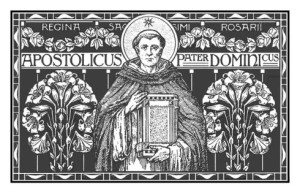 Founded in 1304 it is included here because it is so close to Newry. An Inquisition from 1542/3 records a church, a belfry, chapter house, dormitory, kitchen, and a watermill. In 1552 the priory and waterwheel were granted to Nicholas Bagenal. The Dominicans were back in the district in 1670 when Oliver Plunkett recorded five black friars. In a dispute between the Dominicans and the Franciscans as to which order had the rights to collect alms in Armagh, Down, Dromore, Carlingford and Clogher Oliver Plunkett found in favour of the Dominicans. In 1777, the Prior of Carlingford Dominick Thomas, built a chapel in Dundalk. Enniskillen – The Friary was built at Gola, seven miles south east of the town. The Friary was built after 1660 about the time the Dominicans and the Franiscans were in dispute. That Oliver Plunkett found in favour of the Dominicans near Enniskillen would suggest there was an older settlement.
Founded in 1304 it is included here because it is so close to Newry. An Inquisition from 1542/3 records a church, a belfry, chapter house, dormitory, kitchen, and a watermill. In 1552 the priory and waterwheel were granted to Nicholas Bagenal. The Dominicans were back in the district in 1670 when Oliver Plunkett recorded five black friars. In a dispute between the Dominicans and the Franciscans as to which order had the rights to collect alms in Armagh, Down, Dromore, Carlingford and Clogher Oliver Plunkett found in favour of the Dominicans. In 1777, the Prior of Carlingford Dominick Thomas, built a chapel in Dundalk. Enniskillen – The Friary was built at Gola, seven miles south east of the town. The Friary was built after 1660 about the time the Dominicans and the Franiscans were in dispute. That Oliver Plunkett found in favour of the Dominicans near Enniskillen would suggest there was an older settlement.
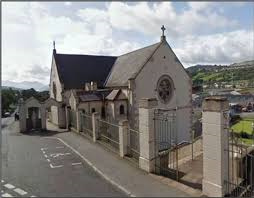 Newry: The only surviving Dominican Priory of Friars is in Newry. The first three fathers and a lay brother arrived in the town on 7th March 1871 to set up a foundation. The first evening the founding fathers slept in a commodious house in McAllister’s terrace, Hyde Park, Newry which is now known as St.Colman’s Park. They stayed here for three months until “The Hermitage” in Upper Chapel Street was ready.
Newry: The only surviving Dominican Priory of Friars is in Newry. The first three fathers and a lay brother arrived in the town on 7th March 1871 to set up a foundation. The first evening the founding fathers slept in a commodious house in McAllister’s terrace, Hyde Park, Newry which is now known as St.Colman’s Park. They stayed here for three months until “The Hermitage” in Upper Chapel Street was ready.
The Fathers were responsible for St.Mary’s Chapel within two weeks of their arrival. This chapel was affectionately known as the “Old Chapel”. Reports at the time say that the mid-day service was attended by large numbers of people and many could not be “accommodated in the building.”
The foundation stone of St. Catherine’s Church was laid and blessed by Dr. Leahy on May 23rd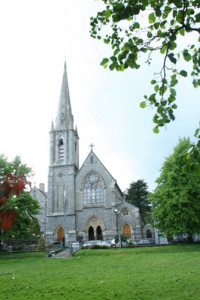 1873. The cost of the building up to dry course level was the gift of a Cork benefactor, a wealthy tanner of the Munster capital. The official opening of the new chapel would mark the end of the Fathers association with “The Old Chapel”. The new Dominican Church of the Sacred Heart and Saint Catherine of Siena – the only Gothic Church of the Order in Ireland architecturally complete with spire – was solemnly dedicated on October 17th 1875.
1873. The cost of the building up to dry course level was the gift of a Cork benefactor, a wealthy tanner of the Munster capital. The official opening of the new chapel would mark the end of the Fathers association with “The Old Chapel”. The new Dominican Church of the Sacred Heart and Saint Catherine of Siena – the only Gothic Church of the Order in Ireland architecturally complete with spire – was solemnly dedicated on October 17th 1875.
Dominican Schools in Ulster
Since the late 1800’s, in addition to the Friars, Dominican nuns have been working in Ulster, mainly in education.
St. Dominic’s Grammar School for Girls on the Falls Road in Belfast was founded in April 25th 1870 with four pupils. Today it has around 1000 girls from 11 to 18 years of age.
In 1917, Nuns from the Falls Road, holidaying in Portstewart saw the need for a girls school there and founded the Dominican College, on rocks overlooking the Atlantic.
In 1930, the Dominican college at Fortwilliam, outside Belfast, was founded.
In 1962, following the raising of the school leaving age, St.Rose’s Dominican
College was established in Beechmount Avenue, Belfast.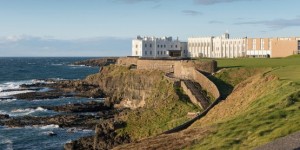
(By Mr. Anthony Russell)